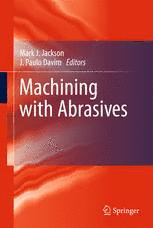Table Of ContentMachining with Abrasives
Mark J. Jackson J. Paulo Davim
l
Editors
Machining with Abrasives
Editors
MarkJ.Jackson J.PauloDavim
PurdueUniversity UniversityofAveiro
MET,CenterforAdvancedManufacturing DepartmentofMechanicalEngineering
CollegeofTechnology 3810-193Aveiro,Portugal
WestLafayette,IN47907-2021 [email protected]
USA
[email protected]
ISBN978-1-4419-7301-6 e-ISBN978-1-4419-7302-3
DOI10.1007/978-1-4419-7302-3
SpringerNewYorkDordrechtHeidelbergLondon
#SpringerScience+BusinessMedia,LLC2011
Allrightsreserved.Thisworkmaynotbetranslatedorcopiedinwholeorinpartwithoutthewritten
permissionof the publisher (SpringerScience+Business Media, LLC, 233 SpringStreet, New York,
NY10013,USA),exceptforbriefexcerptsinconnectionwithreviewsorscholarlyanalysis.Usein
connectionwithanyformofinformationstorageandretrieval,electronicadaptation,computersoftware,
orbysimilarordissimilarmethodologynowknownorhereafterdevelopedisforbidden.
Theuseinthispublicationoftradenames,trademarks,servicemarks,andsimilarterms,eveniftheyare
notidentifiedassuch,isnottobetakenasanexpressionofopinionastowhetherornottheyaresubject
toproprietaryrights.
Printedonacid-freepaper
SpringerispartofSpringerScienceþBusinessMedia(www.springer.com)
Preface
Machiningwithabrasivesisawidelyusedprocessforproducingintricateshapeson
components and artifacts and for providing precise tolerances that are required
especiallyforthemanufactureofengineeringcomponents.Grindingtechnologyis
associated with the current developments in this area and this book contains
chapters on abrasive materials, bonding systems, grinding wheel design, micro
and nanogrinding, control of grinding processes, abrasive grinding, abrasive
water jet grinding, and dressing of grinding wheels. The chapters are written by
subject matterexperts fromaroundthe world andprovideanauthoritative texton
the current developments in machining with abrasive tools. Chapter 1 focuses on
new developments in abrasive materials and associated bonding systems ranging
from conventional abrasives to superabrasive materials. Chapter 2 provides an
interesting prose on heat treatment and the performance of vitrified bonds, while
Chap.3takesalookatthedesignofgrindingwheelsandwheelsafety.Thedressing
of grinding wheels is discussed in Chap.4 and leads into a chapter on the on the
surface integrity in ground surfaces (Chap.5). The control aspect of grinding is
explained lucidly in Chap.6, while Chap.7 focuses on the exciting new area of
nanogrinding. The final chapters deal with polishing with loose abrasive particles
andanauthoritativeoverviewofimpactabrasivemachining.
The structure ofthe book is based on matter provided by many colleagues and
the author wishes to thank the contributors of this book for helping construct a
sourceofknowledgeandinformationonmachiningwithabrasivesandforgranting
theeditorspermissiontousesuchmaterial.Theeditorsalsoacknowledgethehelp
and support of Inderscience Publishers for allowing the chapter contributors and
editors to reproduce their work that was originally published in refereed
Inderscience journals and other refereed journals where permissions have been
acknowledged.
Dr.MarkJ.Jackson
Dr.J.PauloDavim
v
About the Editors
Dr.MarkJ.Jackson
C.Eng.,EngineeringCouncilofLondon,U.K.,1998
M.A.Status,NaturalSciences,University
ofCambridge,U.K.,1998
Ph.D.,MechanicalEngineering,Liverpool,U.K.,1995
M.Eng., Mechanical & Manufacturing Engineering,
Liverpool,U.K.,1991
O.N.D.,MechanicalEngineering,HaltonCollege,
U.K.,1986
O.N.C.PartI,MechanicalEngineering,Halton
College,U.K.,1984
DoctorJacksonbeganhisengineeringcareerin1983whenhestudiedforhisO.N.
C.partIexaminationsandhisfirst-yearapprenticeship-trainingcourseinmechani-
calengineering.AftergaininghisOrdinaryNationalDiplomainEngineeringwith
distinctionsandI.C.I.prizeforachievement,hereadforadegreeinmechanicaland
manufacturingengineeringatLiverpoolPolytechnicandspentperiodsinindustry
working for I.C.I. Pharmaceuticals, Unilever Industries, and Anglo Blackwells.
After graduating with a Master of Engineering (M. Eng.) degree with Distinction
under the supervision of Professor Jack Schofield, M.B.E., Doctor Jackson subse-
quentlyreadforaDoctorofPhilosophy(Ph.D.)degreeatLiverpoolinthefieldof
materials engineering focusing primarily on microstructure-property relationships
invitreous-bondedabrasivematerialsunderthesupervisionofProfessorBenjamin
Mills.HewassubsequentlyemployedbyUnicornAbrasives’CentralResearch&
Development Laboratory (Saint-Gobain Abrasives’ Group) as materials technolo-
gist, then technical manager, responsible for product and new business develop-
ment in Europe, and university liaison projects concerned with abrasive process
development. Doctor Jackson then became a research fellow at the Cavendish
Laboratory,UniversityofCambridge,workingwithProfessorJohnField,O.B.E.,
F.R.S., on impact fracture and friction of diamond before becoming a lecturer in
vii
viii AbouttheEditors
engineering at the University of Liverpool in 1998. At Liverpool, Dr. Jackson
established research in the field of micromachining using mechanical tools, laser
beams, and abrasive particles. At Liverpool, he attracted a number of research
grantsconcernedwithdevelopinginnovativemanufacturingprocessesforwhichhe
was jointly awarded an Innovative Manufacturing Technology Center from the
EngineeringandPhysicalSciencesResearchCouncilinNovember2001.In2002,
he became associate professor of mechanical engineering and faculty associate in
theCenterforManufacturingResearch,andCenterforElectricPoweratTennessee
TechnologicalUniversity(anassociateduniversityofOakRidgeNationalLabora-
tory), and a faculty associate at Oak Ridge National Laboratory. Dr. Jackson was
the academic adviser to the Formula SAE Team at Tennessee Technological
University. In 2004 he moved to Purdue University as Professor of Mechanical
EngineeringintheCollegeofTechnology.
Doctor Jackson is active in research work concerned with understanding the
propertiesofmaterialsinthefieldofmicroscalemetalcutting,micro-andnanoab-
rasive machining, and laser micro machining. He is also involved in developing
nextgenerationmanufacturingprocesses.DoctorJacksonhasdirected,co-directed,
andmanagedresearchgrantsfundedbytheMedicalResearchCouncil,Engineering
andPhysicalSciencesResearchCouncil,TheRoyalSocietyofLondon,TheRoyal
Academy of Engineering (London), European Union, Ministry of Defense (Lon-
don), Atomic Weapons Research Establishment, National Science Foundation, N.
A.S.A.,U.S.DepartmentofEnergy(throughOakRidgeNationalLaboratory),Y12
National Security Complex at Oak Ridge, Tennessee, and Industrial Companies,
which has generated research income in excess of $15 million. Dr. Jackson has
organized many conferences and served as GeneralChairman of the International
Surface Engineering Congress and is Deputy President of the World Academy of
Materials and Manufacturing Engineering. He has authored and co-authored over
250 publications in archived journals and refereed conference proceedings, has
written a book on “micro and nanomanufacturing”, is guest editor to a number of
refereedjournals,andhaseditedabookon“commercializingmicro-andnanotech-
nologyproducts”.Heistheco-editorofthe“JournalofManufacturingTechnology
Research”, associate editor of the “International Journal of Molecular Engineer-
ing”,andisontheeditorialboardsofthe“InternationalJournalofMachiningand
Machinability of Materials”, “International Journal of Computational Materials
ScienceandSurfaceEngineering”,“InternationalJournalofNanomanufacturing”,
“InternationalJournalofNanoandBiomaterials”,andthe“InternationalJournal
ofManufacturingResearch”.
AbouttheEditors ix
Dr.J.PauloDavim
Aggregation,MechanicalEngineering,University
ofCoimbra,Portugal,2005
Ph.D.,MechanicalEngineering,UniversityofPorto,
Portugal,1997
M.Sc.,MechanicalEngineering(Materials
&ManufacturingProcesses),University
ofPorto,Portugal,1991
Graduation(5years),MechanicalEngineering,
UniversityofPorto,Portugal,1986
DoctorJ.PauloDavimreceivedhisPh.D.degreeinMechanicalEngineeringfrom
the University of Porto in 1997 and the Aggregation from the University of
Coimbra in 2005. Between, 1986/96, he was lecturer in University of Porto.
Currently,heisanAggregateProfessorattheDepartmentofMechanicalEngineer-
ing of the University of Aveiro and the Head of MACTRIB - Machining and
TribologyResearchGroup.Hehasmore24yearsofteachingandresearchexperi-
ence in manufacturing, materials and mechanical engineering. His main research
interests are the machining and tribology and more recently the application of
computational and statistical methods in manufacturing as well as all aspects of
sustainable manufacturing. He was coordinator of several research projects and
supervisor of 2 Ph.D. thesis and 10 M.Sc. thesis. He is Guest Editor of journals,
book Series Editor and Scientific Advisory for many international journals and
conferences.Presently,heisanEditorialBoardmemberof15internationaljournals
andactsasreviewerforthan45prestigiousISIwebSciencejournals.Hehasalso
publishedmorethan20bookchaptersand300articlesinjournalsandconferences
(more150articlesinISIWebScience,h-index15).
HeistheEditorofthe“InternationalJournalofMachiningandMachinabilityof
Materials”, “International Journal of Manufacturing, Materials and Mechanical
Engineering”, “Journal of Machining and Forming Technologies”, “Journal of
ModernManufacturingTechnology”and Co Editor ofthe “International Journal
ofSurfaceScienceandEngineering”,“InternationalJournalofMechatronicsand
ManufacturingSystems”,“InternationalJournalofMaterialsEngineeringInnova-
tion”,andthe“JournalofManufacturingTechnologyResearch”.

